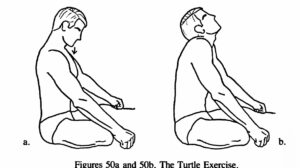Below will gradually more and more examples on integration of Eastern and Western medicine be discussed
- The integrated turtle strategy
(NB the Turtle version I use for integrating is not the only but one of those Turtle versions developed within Eastern Medicine)
“The Turtle stretches the entire spine, energizes the neck, strengthens the shoulder muscles, and removes tiredness, stiffness and soreness from neck and shoulders. In addition, the thyroid and parathyroid glands are stimulated and strengthened, improves the body´s metabolism. If one performs the Turtle on a daily basis, one will feel younger and radiate and inner beauty which comes only through the proper functioning of one´s inner energy systems” (The complete system of self-healing: internal exercises, by Stephen T Chang, 1985), p.114-115 ).
(with respect to descriptions made hundreds or thousands years ago, we do not need take this nowadays (out of today knowledge/thinking) literary.
Adding to the above I use (a) a hypnosis behavioral strategy, (b) pressing lips (evolutionary reasons) at inhaling and (c) slow carful head scrolling movement at exhalation. Sometimes adding (d) imaging (my behavior from within or ..) and (e) verbalizations as “active (in-) and relaxed (exhaling)” to conditioning behaviors to both spatial and verbal expressions. Gradually new innovative adjunctive ideas may emerge, which I document and the separate test before (perhaps) include adding or replacing the actual integrated version. NB no fast changes … Using the above in clinical settings it requires well planed together with users enabling them to tailor the prototype …
Also, the above process strategy can be psychophysiological documented using our cStress lab (see cStress mätsystem | Stressmedicin NB Swedish text). That is validate the process with dynamic data from autonomic nervous system and part of cell metabolisms behaviors, something crucial in most health related processes. We can see the present effects in the light of exercise over time. Really, increase scientific power as well as motivating users very much, given data is carful used and patients have learned what data can “say” (see below)!
BUT, I must admit that the above may be too much for some! BUT, as I see it, perfect in clinical context, as e.g. our “group educational setting supervised practice”, a very effective way to work. The benefit from a complex strategy is that over time you just need a few of the adjunctives to get the whole. How come? Through Limbic operational conditioning.
2. Is coming …
